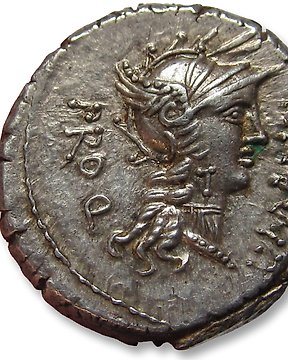
République romaine. L. Cornelius Sulla & L. Manlius Torquatus Proquaestor. Denarius mint moving with Sulla 82 B.C.
Nº 87551715

Nº 87551715

Ancient Greek - Kingdom of Mauretania
KINGS of MAURETANIA. Juba II, with Kleopatra Selene. 25 BC-AD 24. Silver denarius (3,07 g. 17 mm.). Caesarea mint, 17-18 A.D.
REX IVBA, diademed head to right
Headdress of Isis surmounted by corn ears on left, sistrum on right; BA-CIΛI-CCA across fields, KΛЄΟΠΑΤΡA in exergue
Mazard 311; MAA 99; SNG Copenhagen 570
Good VF, old cabinet patina.
Interesting bilingual issue. Juba II was born about 50 BC, the son of King Juba of Numidia who lost his kingdom and his life following Caesar's victory over the Pompeians at Thapsus in 46 BC. The child was brought to Rome to adorn the dictator's triumph and then remained in the capital, where he received his education and was later granted Roman citizenship. During this time, he became a close friend of Octavian, thirteen years his senior. In 25 BC, Octavian, now Rome's first emperor under the name of Augustus, granted his friend Juba the North African Kingdom of Mauretania, which had been annexed by the Romans following the death of Bocchus III in 33. About five years later, Juba II married the 20 year old Cleopatra Selene, daughter of Mark Antony and Queen Cleopatra VII of Egypt, who had been brought up by the emperor's sister, Octavia, following her parents' suicide in Alexandria in 30 BC. Their rule over Mauretania was benevolent, and quite prosperous, though there was constant border security problems. Juba survived to an advanced age and was eventually succeeded by Ptolemy, his son by Cleopatra Selene, in AD 24.
Please see the photos for a better impression.
6157 2024-4624.
Comment acheter sur Catawiki ?
1. Découvrez des objets d’exception
2. Faites la meilleure offre
3. Effectuez un paiement sécurisé